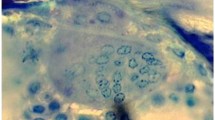Summary
This report is the first cytochemical investigation of vanishing bone disease “Gorham's Disease” (Gorham and Stout 1955). The ultrastructural localization of nonspecific alkaline phosphatase and of specific and non-specific acid phosphatase activity was studied in slices of tissue removed from a patient with this rare disorder. Sodium β-glycerophosphate and phosphorylcholine chloride were used as substrates. Alkaline phosphatase was present around the plasma membranes of osteoblasts and associated with extracellular matrix vesicles in new woven bone. This is consistent with the proposed role for this enzyme (Robison 1923) and for matrix vesicles (Bonucci 1967) in the mineralization of bone (Bernard and Marvaso 1981). Concentrations of specific secretory acid phosphatase reaction product in the cytoplasm of degenerating osteoblasts may contribute to the imbalance between bone formation and resorption. Osteoclasts, while few in number, showed nonspecific and specific acid phosphatase activity. The Golgi apparatus and heterophagic lysosomes of mononuclear phagocytes were rich in non-specific acid phosphatase. This was also present in the Golgi lamellae and lysosomes of endothelial cells. Acid phosphatase cytochemistry suggests that mononuclear phagocytes, multinuclear osteoclasts and the vascular endothelium are involved in bone resorption in this disease.
Similar content being viewed by others
References
Anderson HC (1973) Calcium-accumulating vesicles in the intercellular matrix of bone. In: Hard tissue growth, repair and remineralization. Ciba Foundation Symposium 11. Elsevier, Amsterdam, pp 213–225
Anderson HC (1976) Matrix vesicles of cartilage and bone. In: Bourne GH (ed) The biochemistry and physiology of bone, vol 4. Academic Press, New York, pp 135–157
Barka T, Anderson PJ (1962) Histochemical methods for acid phosphatase using hexazonium pararosanilin as coupler. J Histochem Cytochem 10:741–753
Bernard GW, Marvaso V (1981) Matrix vesicles as an assay for primary tissue calcification in vivo and in vitro. In: Ascenzi A, Bonucci E, de Bernard B (eds) Matrix vesicles. Wichtig, Milano, pp 5–11
Bonucci E (1967) Fine structure of early cartilage calcification. J Ultrastruct Res 20:33–50
Cannon SR (1986) Massive osteolysis. J Bone Joint Surg [Br] 68 B:24–28
Caulet T, Fandre M, Adret JJ, Coffin R, Pennaforte F, Matthey J (1968) Ostéolyse massive scapulo-cléido-costale: étude histochemique et ultrastructurale. Ann Pathol Anat (Paris) 13:177–200
Dickson GR (1982) The resorption of woven bone in rat fracture callus. In: Silbermann M, Slavkin HC (eds) Current advances in skeletogenesis. Excerpta Medica, Amsterdam Oxford Princeton, pp 100–105
Dickson GR, Mollan RAB, Hayes D (1986) TEM studies on mineralization and resorption in vanishing bone disease. In: Ali SY (ed) Cell mediated calcification and matrix vesicles. Excerpta Medica, Amsterdam New York London, pp 403–408
Doty SB, Schofield BH (1984) Ultrahistochemistry of calcified tissues. In: Dickson GR (ed) Methods of calcified tissue preparation. Elsevier, Amsterdam New York Oxford, pp 149–198
Fullmer HM, Link CC (1964) A demineralization procedure for enzymatic histochemical use: a quantitative succinic dehydrogenase assay. Stain Technol 39:387–396
Gibbons JR, Grimstone AV (1960) On flagellar structure in certain flagellates. J Biophys Biochem Cytol 7:697–715
Gorham LW, Stout AP (1955) Massive osteolysis (acute spontaneous absorption of bone, phantom bone, disappearing bone): its relation to haemangiomatosis. J Bone Joint Surg [Am] 37A:985–1004
Greep RO, Fischer CJ, Morse A (1948) Alkaline phosphatase in odontogenesis and osteogenesis and its histochemical demonstration after demineralization. J Am Dent Assoc 36:427–442
Heersche JNM (1978) Mechanisms of osteoclast bone resorption: a new hypothesis. Calcif Tissue Res 26:81–84
Heyden G, Kindblom LG, Nielsen JM (1977) Disappearing bone disease: a clinical and histological study. J Bone Joint Surg [Am] 59A:57–61
Johnson PM, McClure JG (1958) Observations on massive osteolysis: a review of the literature and report of a case. Radiology 71:28–42
Kurahashi Y, Yoshiki S (1972) Electron microscopic localization of alkaline phosphatase in the enamel organ of the young rat. Arch Oral Biol 17:155–163
Lucht U (1971) Acid phosphatase of osteoclasts demonstrated by electron microscopic histochemistry. Histochemie 28:103–117
Meachim G, Roy S (1967) Intracytoplasmic filaments in the cells of adult human articular cartilage. Ann Rheum Dis 26:50–58
Reynolds ES (1963) The use of lead citrate at high pH as an electron-opaque stain in electron microscopy. J Cell Biol 17:208–212 (1963)
Robison R (1923) The possible significance of hexosephosphoric esters in ossification. Biochem J 17:286–293
Schenk RK (1980) Basic histomorphology and physiology of skeletal growth. In: Weber BG, Brunner C, Freuler F (eds) Treatment of fractures in children and adolescents. Springer, Berlin Heidelberg New York, pp 3–19
Schofield BH, Mulhern HL McDonald DF (1977) Acid phosphorylcholine phosphatase of sebaceous glands and osteoclasts. J Histochem Cytochem 25:309–310
Author information
Authors and Affiliations
Rights and permissions
About this article
Cite this article
Dickson, G.R., Mollan, R.A.B. & Carr, K.E. Cytochemical localization of alkaline and acid phosphatase in human vanishing bone disease. Histochemistry 87, 569–572 (1987). https://doi.org/10.1007/BF00492472
Accepted:
Issue Date:
DOI: https://doi.org/10.1007/BF00492472




